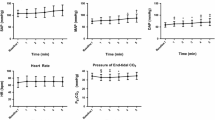Abstract
Recent studies suggest that significant physiologic derangements can occur during laparoscopic surgery. Eighteen patients admitted for laparoscopic cholecystectomy were studied. The mean age was 46.7 (range 19–78). A standard anesthetic technique, reverse Trendelenburg positioning, and an abdominal insufflation pressure of 15 mmHg with CO2 were used with all subjects. Central venous pressure (CVP) and arterial pressures were measured invasively. Stroke volume and cardiac index were calculated using quantitative transesophageal echocardiography. Baseline measurements were taken after induction. Additional measurements were taken at 15-min intervals throughout the procedure. There was a statistically significant increase in mean arterial pressure (15.9%), systolic blood pressure (11.3%), diastolic blood pressure (19.7%), and CVP (30.0%) from control baseline values. Significant decreases in stroke volume (29.5%) and cardiac index (29.5%) occurred within 30 min of the induction of pneumoperitoneum and positioning (P<0.05, ANOVA). Laparoscopic cholecystectomy significantly and reversibly decreases cardiac performance. Compromised patients may be at increased risk for complications not previously recognized with this procedure.
Similar content being viewed by others
References
Brampton W, Watson R (1990) Arterial to end-tidal carbon dioxide tension difference during laparoscopy. Anaesthesia 45: 210–214
Diebel L, Dulchavsky S, Wilson R (1992) Effect of increased intra-abdominal pressure on mesenteric arterial and intestinal mucosal blood flow. J Trauma 33: 45–49
Ekman L, Abrahamsson J, Forssman L, Milsom I, Sjoqvist B (1988) Hemodynamic changes during laparoscopy with positive end-expiratory pressure ventilation. Acta Anesthesiol Scand 32: 447–453
Ho H, Gunther R, Wolfe B (1992) Intraperitoneal carbon dioxide insufflation and cardiopulmonary functions. Arch Surg 127: 928–933
Ivankovich A, Miletich D, Albrecht R, Heyman H, Bonnet R (1975) Cardiovascular effects of intraperitoneal insufflation with carbon dioxide and nitrous oxide in the dog. Anesthesiology 42: 281–287
Johannsen G, Andersen M, Juhl B (1989) The effect of general anaesthesia on the haemodynamic events during laparoscopy with CO2 insufflation. Acta Anaesthesiol Scand 33: 132–36
Kashtan J, Green J, Parsons E, Holcroft J (1981) Hemodynamic effects of increased intra-abdominal pressure. J Surg Res 30: 249–255
Kelman G, Swapp G, Smith I, Benzie R, Gordon N (1972) Cardiac output and arterial blood gas tension during laparoscopy. Br J Anaesthesiol 44: 1155–1161
Kleinhaus S, Sammartano R, Boley S (1978) Effects of laparoscopy on mesenteric blood flow. Arch Surg 113: 867–869
Liu S, Leighton T, Davis I, Klein S, Lippmann M, Bongard F (1991) Prospective analysis of cardiopulmonary responses to laparoscopic cholecystectomy. J Laparoendosc Surg 5: 241–46
Marshall R, Jebson P, Davie I, Scott D (1972) Circulatory effects of carbon dioxide insufflation of the peritoneal cavity for laparoscopy. Br J Anaesthesiol 44: 680–684
Melville R, Frizis H, Forsling M, LeQuesne L (1985) The stimulus for vasopressin release during laparoscopy. Surg Gynecol Obstet 161: 253–256
Motew M, Ivankovich A, Bieniarz J, Albrecht R, Zahed B, Scommegna A (1973) Cardiovascular effects and acid-base and blood gas changes during laparoscopy. Am J Obstet Gynecol 115: 1002–1012
Myles P (1991) Bradyarrhythmias and laparoscopy: A prospective study of heart rate changes with laparoscopy. Aust N Z J Obstet Gynaecol 31: 171–173
Sakuramachi S, Kimura T, Yoshida M, Oba N, Umehara Y, Matsuda H, Nakabayashi N, Kawabe A, Matsui N, Wada H, Imaizumi T, Harada Y (1991) Hemodynamic effects of peritoneal insufflation during laparoscopic cholecystectomy. Surg Laparosc Endosc (Abstr) 1: 131
VanDenBos G, Drake A, Noble M (1979) The effect of carbon dioxide on myocardial contractile performance, blood flow and oxygen consumption. J Physiol 287: 149–161
Versichelen L, Serreyn R, Rolly G, Vanderkerckhove D (1984) Physiologic changes during anesthesia administration for gynecologic laparoscopy. J Reprod Med 29: 697–700
Westerband A, Van De Water J, Amzallag M, Lebowitz P, Nwasokwa O, Chardavoyne R, Abou-Taleb A, Wang X, Wise L (1992) Cardiovascular changes during laparoscopic cholecystectomy. Surg Gynecol Obstet 175: 535–538
Wittgen C, Andrus C, Fitzgerald S, Baudendistel L, Dahms T, Kaminski D (1991) Analysis of the hemodynamic and ventilatory effects of laparoscopic cholecystectomy. Arch Surg 126: 997–1001
Wolfe B, Gardiner B, Leary B, Frey C (1991) Endoscopic cholecystectomy; an analysis of complications. Arch Surg 126: 1192–1198
Author information
Authors and Affiliations
Rights and permissions
About this article
Cite this article
McLaughlin, J.G., Scheeres, D.E., Dean, R.J. et al. The adverse hemodynamic effects of laparoscopic cholecystectomy. Surg Endosc 9, 121–124 (1995). https://doi.org/10.1007/BF00191950
Received:
Accepted:
Issue Date:
DOI: https://doi.org/10.1007/BF00191950




